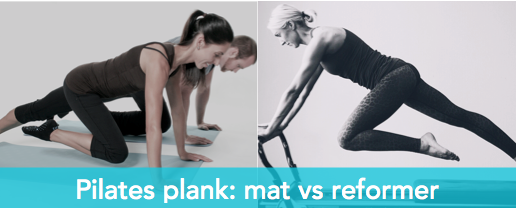Pilates plank: mat vs reformer
Mat based exercises can often translate effectively to the reformer, the difference on the reformer being the incorporation of a moving base of support (carriage) with possibilities of varying levels of resistance being added via springs. Mat based exercises predominantly utilise body weight to provide resistance, with the optional addition of props to either support or further challenge the movement.
The Plank position itself in terms of alignment is effectively the same on the reformer or the mat, the difference being on the reformer that your feet are on the carriage and your hands can be on the bar which is generally elevated, so your hands are higher than your feet compared to being at the same level when performed on the mat. This could mean that people who find loaded wrist extension uncomfortable, could find the plank more achievable on the reformer. However; the plank could also be performed with hands on the foot plate, effectively allowing for the same wrist position as on the mat.
The varying resistance of the springs means that the core challenge can be progressed gradually if incorporating a hip & knee flexion/extension component (knee stretch/long stretch) A heavier spring applied to the carriage will challenge lower limb extension as the carriage is pushed away, but generally reduce the challenge to the trunk. By gradually decreasing the spring resistance over time, you can progressively increase the challenge to the trunk and eccentric control of the hip & knee flexion component as the carriage returns. A similar knee stretch movement can be applied to the plank on the mat by placing a swiss ball under the shins, starting in a tuck or shell stretch position, or if you prefer to start in a similar position to the reformer version, a foam roller under the shins, which is rolled out when straightening the knees can mimic the carriage. The foam roller variation can be far more challenging to control however as it creates quite an unstable base which has to be completely controlled with out any support from spring resistance.
On the mat, the plank can be taught safely in incriments quite effectively and comfortably for beginners with a stable base. You can commence training peoples awareness and upper quadrant and truck control simply by training 4 point kneel positioning in exercises such as swimming, cat stretch, and leg pull in prone preparation level 1. This then progresses to leg pull in prone preparation level 2, which is effectively the plank position. From here more advanced variations can be introduced such as the foam roller variation mentioned and the knee tuck shown in the photograph. these variations will challenge control, endurance and dissociation. To perform the exercise on the reformer, people should feel confident on a moving base, even if it is quite loaded with springs. The reformer allows an easy flow to be applied to the movement if you want to incorporate a sequence. For example, starting with a knee stretch or long stretch variation, (moving carriage in and out) holding a plank, incorporating a push up or leg pull then coming into a pike or elephant.
So, as you can see the requirements of your particular client and the aims of your Pilates session will determine your choice to use the reformer or the mat. Incorporating variations on both will ultimately provide a multitude of benefits and challenges to get your clients moving well.
Pilates plank: mat vs reformer
 Unite Health Management are the official providers of APPI Pilates Teacher Training courses across Australia. You can view our upcoming course schedule here.
Unite Health Management are the official providers of APPI Pilates Teacher Training courses across Australia. You can view our upcoming course schedule here.
 Unite Health Management are the official providers of APPI Pilates Teacher Training courses across Australia. You can view our upcoming course schedule here.
Unite Health Management are the official providers of APPI Pilates Teacher Training courses across Australia. You can view our upcoming course schedule here.
